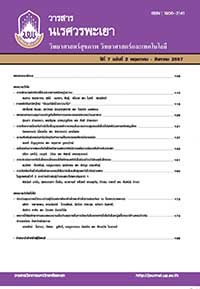การผลิตทันตวัสดุใหม่ “ซีเมนต์ยึดชั่วคราวนาโน”
Keywords:
สารเชื่อมยึดชั่วคราว, ซิงค์ออกไซด์ยูจีนอลซีเมนต์, การรั่วซึม, การเปลี่ยนแปลงอุณหภูมิร้อน-เย็นเป็นจังหวะ, ความทนแรงอัด, temporary cement, zinc oxide eugenol cement, microleakage, thermocycling, compressive strengthAbstract
การใส่ครอบฟันชั่วคราว มักพบปัญหาการรั่วซึมของแบคทีเรียและของเหลวภายในช่องปาก นอกจากนี้ซีเมนต์ทางทันตกรรมทั้งหมดที่ใช้ภายในประเทศไทยต้องสั่งนำเข้าจากต่างประเทศ การใช้คุณสมบัติของวัสดุนาโนคาดว่าจะสามารถเพิ่มประสิทธิภาพกันการรั่วซึมของซีเมนต์ยึดครอบฟันได้ งานวิจัยนี้มีจุดประสงค์เพื่อผลิต ทันตวัสดุสิ้นเปลือง “วัสดุนาโน-ซีเมนต์ยึดชั่วคราว” มุ่งเน้นศึกษาประสิทธิภาพป้องกันการรั่วซึม และความทนแรงอัดของซีเมนต์ยึดครอบฟันชั่วคราวที่ทำจากสารอคริลิกเปรียบเทียบกัน 4 ชนิด ได้แก่ ซีเมนต์ยึดชั่วคราวจากทางการค้า (บริษัทเคอร์ สหรัฐอเมริกา), ซีเมนต์ยึดชั่วคราวที่ผลิตได้เอง 3 สูตร ได้แก่ สูตร 1ใช้วัสดุขนาดไมโครเมตรทั้งหมด, สูตร 2 เพิ่มวัสดุนาโนและสูตร 3 เพิ่มวัสดุนาโนและนาโนไทเทเนียมไดออกไซด์ ประสิทธิภาพป้องกันการรั่วซึม แต่ละกลุ่มใช้ฟันธรรมชาติกรามน้อยซี่ที่ หนึ่งบน(upper first bicuspid) จำนวน 25 ซี่ วัดจากระดับการซึมของสี (Dye Penetration Test) การหาค่าความทนแรงอัดอ้างอิงมาตรฐาน ANSI/ADA specification no.30 เปรียบเทียบค่าทั้ง 4 กลุ่ม จากผลการทดลองพบว่า ค่าการรั่วซึมกลุ่มที่ 1, 2, 3, 4 เท่ากับ 0.456, 0.647, 0.285, 0.354 มม. ตามลำดับ ส่วนความทนแรงอัด เท่ากับ 6.64, 3.45, 4.65, 6.08 เมกะปาสกาล(MPa) ตามลำดับ และเมื่อนำซีเมนต์ทั้ง 4 ชนิดมาวิเคราะห์โครงสร้างทางจุลภาคด้วยเทคนิค สแกนนิ่งอิเล็กตรอนไมโคสรสโคป (sem) พบว่าซีเมนต์ยึดชั่วคราวชนิดที่ 4 ได้ฟิล์มที่บางและแนบสนิทกับฟันดีกว่าซีเมนต์ชนิดอื่น
New production of dental materials “Nano-temporary cement”
Pramote Limkool1*, Aphiwat Teetawutgulrug2 and Robert Molloy2
1* School of Dentistry, University of Phayao, Phayao Province 56000
2 Faculty of Science, Chiang Mai University, Chiang Mai Province 50200
Temporary crowns result in microleakage because of cracks in the temporary dental cements. All temporary cements made in Thailand are imported. Nano-materials can improve the properties of temporary cement. The aims of this investigation were, first, to develop a locally made temporary cement of high quality that meets universal standards to evaluate and compare the microleakage and compressive strength of the new temporary cement with imported commercial temporary cement. Microleakage test: four groups of 25 natural upper first bicuspid teeth were prepared for temporary crowns. In the first group, temporary crowns were cemented with the commercially available cement (Kerr, USA) and in the 2nd, 3rd, and 4th groups with the new temporary cements. The dye penetrated the microleakage space, enabling the latter to be measured. Compressive strength test: following ANSI/ADA Specification No. 30. The results showed that the 1st, 2nd, 3rd and 4th groups had microleakages of 0.456, 0.647, 0.285, 0.354 mm, and compressive strengths of 6.64, 3.45, 4.65 and 6.08 MPa, respectively. Under the experimental conditions used in this study, there was less microleakage with the new temporary cements 4th group than with the commercial temporary cement. The nano -materials could decrease microleakage while the titanium dioxide could improve the compressive strength of the temporary dental cement.
Downloads
Published
How to Cite
Issue
Section
License
ผู้นิพนธ์ต้องรับผิดชอบข้อความในบทนิพนธ์ของตน มหาวิทยาลัยพะเยาไม่จำเป็นต้องเห็นด้วยกับบทความที่ตีพิมพ์เสมอไป ผู้สนใจสามารถคัดลอก และนำไปใช้ได้ แต่จะต้องขออนุมัติเจ้าของ และได้รับการอนุมัติเป็นลายลักษณ์อักษรก่อน พร้อมกับมีการอ้างอิงและกล่าวคำขอบคุณให้ถูกต้องด้วย
The authors are themselves responsible for their contents. Signed articles may not always reflect the opinion of University of Phayao. The articles can be reproduced and reprinted, provided that permission is given by the authors and acknowledgement must be given.








